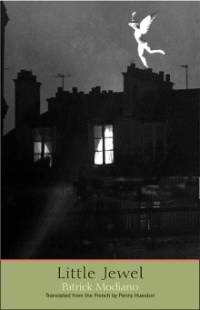Little Jewel by Patrick Modiano
 Friday, September 30, 2016 at 7:05AM
Friday, September 30, 2016 at 7:05AM 
First published in France in 2001. Published in translation in Australia in 2015. Published by Yale University Press on August 23, 2016
Nobel winner Patrick Modiano is supposedly noted for works that explore the nature of memory and identity (I wouldn’t know, having never read him before). Those themes are certainly at the heart of Little Jewel. Many things are missing from the young protagonist’s life, including memories, and it is up to the reader to guess where they have gone.
When Thérèse Cardères was younger, she was called Little Jewel. She recalls “Little Jewel” as a stage name, one that her mother used to show her off as a piece of jewelry. Thérèse has ambiguous memories of a film in which she and her mother played a role. She also recalls her mother playing a better mother in the film than she was in real life.
Thérèse is now 19. Her mother died in Morocco 12 years earlier. Yet Thérèse spots a woman wearing a yellow coat in a train station and becomes convinced that the woman is her mother, that her mother has been living a secret life. In fact, she has believed for some time that her mother, even when alive, was living a secret life and using a false identity. Seeing the woman in the yellow coat triggers memories that Thérèse reveals over the course of the novel. She also begins to have dreams about her mother (including one in which her mother has been branded) that may be more revealing than her memories.
Thérèse follows the woman, traces her to an apartment, but cannot bring herself to speak to the woman. Instead, she talks to neighbors about the woman. The stories they tell confirm Thérèse’s impression that the woman is her mother. Yet Thérèse tells her own stories about her past to the reader, and tells a different version of her life story to a pharmacist who befriends her, leaving the reader to wonder which of the memories that Thérèse relates are reliable.
Thérèse gets a job as a nanny for a mysterious couple who have a six-year-old girl. The girl’s mother reminds Thérèse of her own mother -- cold and distant -- while the girl reminds Thérèse of herself. This is one of multiple examples of identify confusion that pop up during the course of the novel.
A number of images recur throughout the novel -- black dogs, a yellow coat, the absence of chairs in a man’s study, a certain kind of music, vague sounds that may be voices or blowing leaves -- that will give literary-minded readers who search for symbols plenty to chew on. Relationships between the characters and the malleable nature of memories would also provide ample essay material if Little Jewel were assigned reading in a literature course.
Thérèse is an enigmatic character. Why doesn’t she speak to the woman who might be her mother? She isn’t quite a stalker, but she investigates the woman without gathering the courage to confront her. Is she afraid to confront her past? Thérèse’s memories of her mother and of her past are not perfectly consistent, suggesting that her present may be shaped by memories of the past that she has shaped to suit her present needs.
Thérèse spends much of her time walking the streets of Paris, often comparing it to the streets she knew as a child. She perceives the city differently by day than by night; as in childhood, she still associates darkness with the sense of being lost. She reveals her loneliness by clinging to people she meets, including a linguist who helps her explore her almost-forgotten memories. One of the people she meets, the pharmacist, treats Thérèse as would a mental health worker who is concerned about Thérèse’s emotional stability. The pharmacist’s behavior may be a clue to what’s really going on.
Gaps in Thérèse’s history invite questions. Why is she so afraid of traveling alone in Paris? Who were the men in her mother’s life? What kind of “dancer” and “actress” was her mother? What happened to Thérèse’s dog? Is Thérèse suited to be a nanny and what’s up with the mysterious parents who hired her? Why are there so many parallels and similarities between the lives of various characters of the past and present? Why does Thérèse believe that visiting the past might allow her to find a new path that will make everything turn out differently? A number of answers can be imagined to these questions, and different readers might answer them differently. The ending, I think, requires the reader to reimagine the entire novel, although I must confess that I don't know whether how I did so is the right or the best way.
Little Jewel is the kind of book that demands a close reading, and probably a rereading, in order to plumb its hidden meanings. That won’t appeal to readers who want everything laid out on a platter -- the novel’s ambiguities are at times frustrating -- but readers who enjoy being challenged to divine a novel’s multiple meanings should find Little Jewel appealing.
RECOMMENDED